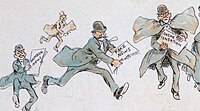
Photo from wikipedia
The advances on the Internet and news media technologies suggest intelligent and personalised media interfaces in order to improve reading efficiency of news readers and enhance news disseminations. Cognitive load… Click to show full abstract
The advances on the Internet and news media technologies suggest intelligent and personalised media interfaces in order to improve reading efficiency of news readers and enhance news disseminations. Cognitive load is one of factors that affect the understanding ability of news readers and therefore news dissemination. It is expected that the display elements in an intelligent user interface of news media could be automatically adjusted to modulate the audience’s perceived cognitive load level in order to improve the news reading efficiency. While the font style and font colour of news text are the main display elements in the user interface of news media, it is not clear how these elements affect perceived cognitive load of news readers. This paper investigates perceived cognitive load of news readers under different font style and font colour conditions. Experiments with the news text in Chinese as a case study found that the change of text font style of keywords resulted in the increase of the reader’s perceived cognitive load during reading news text under the low introduced cognitive load and blue colour displayed keywords. While under the high introduced cognitive load, the italic font and red colour of keywords text resulted in the decrease of the reader’s perceived cognitive load significantly during reading news text, which therefore improves the news reading efficiency. This paper is limited to the effects of two aspects of news text (font styles and colours) on user’s perceived cognitive load. The future work will focus on the investigation of effects of other factors such as news pictures and their colours, numbers, and locations on user’s perceived cognitive load.
Journal Title: IEEE Access
Year Published: 2022
Link to full text (if available)
Share on Social Media: Sign Up to like & get
recommendations!